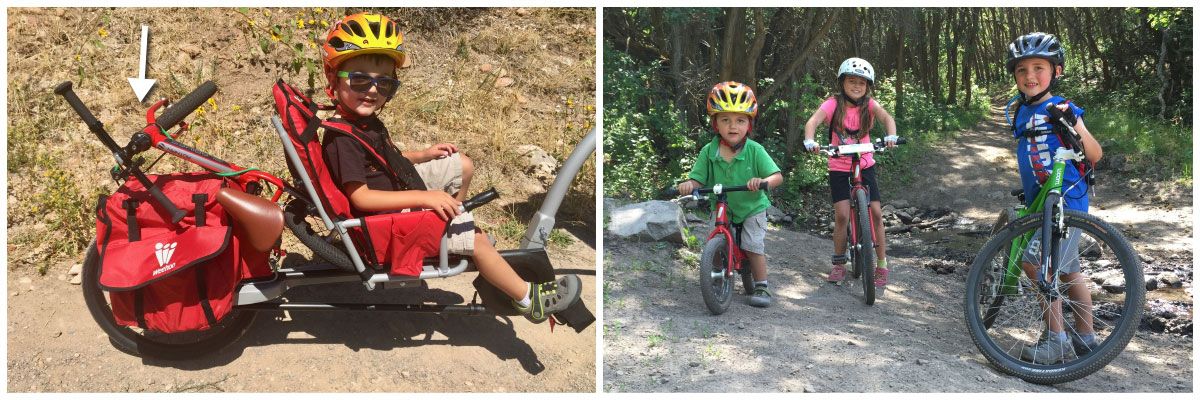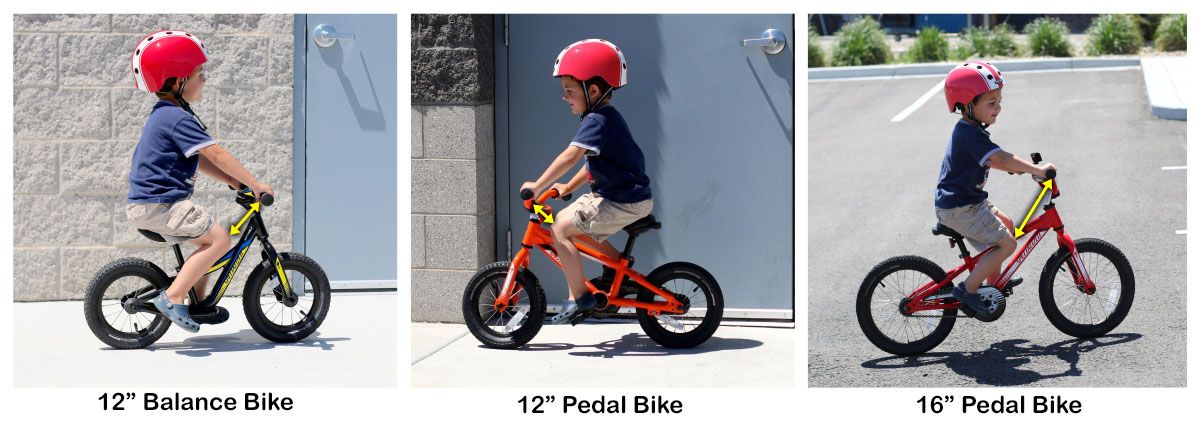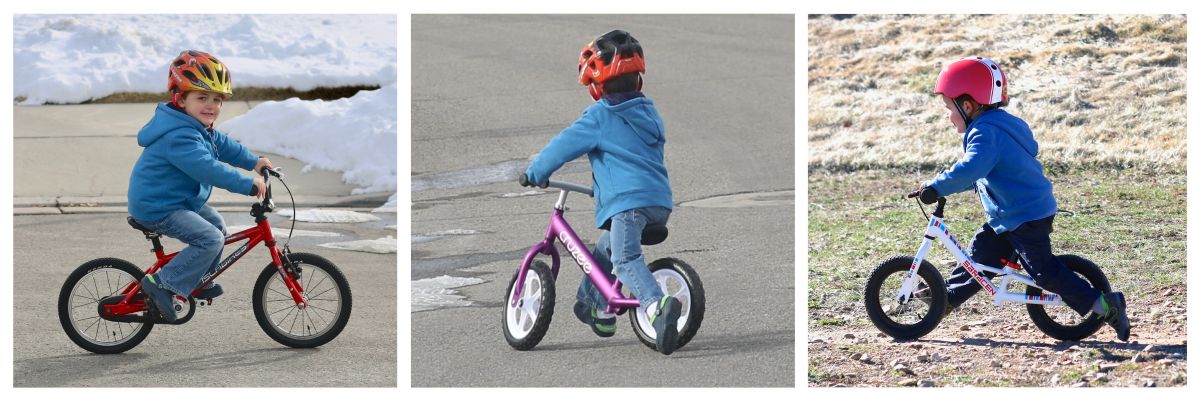Is your child is ready to transition from a balance bike to a pedal bike?
One of the many benefits of a balance bike is you child can skip the drama of training wheels. When you transition your child from a balance bike to a pedal bike at the right time, most balance bike graduates figure out how to pedal in just a few minutes. They just jump on a bike, starting running with their feet, and then pedal away. No training wheels (or tears and tantrums) ever required!!
But how do you know when your child is ready to easily and smoothly make that transition? While the answer isn’t the same for every child, knowing what to look for and what to avoid will help you determine if your child is ready to pedal away!

3 Signs Your Rider is Ready to Make the Switch
There are three key indicators that your child is ready to move on from a balance bike and tackle the new and brave world of pedal bikes. Your child needs to satisfy all three of these requirements:
- They have mastered a balance bike.
- They have good hand/eye coordination and are developmentally ready.
- They are asking for a pedal bike.
1. They’ve mastered a balance bike.
Mastering a balance bike goes beyond just riding down the driveway and up and down the sidewalk. A master balance bike rider can ride for long distances and on various terrains. Observe your child and see if they commonly display these skills:
- Riding up and down a curb or ramp
- Riding for over a mile
- Zig-zagging their way through cones or weaving in and out of obstacles

In addition to learning how to balance while seated on a bike, true balance bike masters have also developed advanced skills that make the transition to a pedal bike pretty seamless. Kids that are the best prepared to tackle a pedal bike can do the following:
- Shift their weight in and out of a turn
- Lean forward or back while going up or down a hill
- Make a sharp turn without jackknifing
- Steer into a fall to prevent themselves from falling

While these more advanced skills can all be learned on a pedal bike, kids are much less likely to get hurt while learning these skills on their balance bike. Learning these skills takes time, experience, and trial and error. The greater mastery a child has of these skills while on a balance bike, the easier and less stressful the transition to a pedal bike will be.
2. They have good hand/eye coordination and are developmentally ready.
This one is tricky. There really isn’t a clear developmental milestone to look for to ensure your child is ready. Pedaling a bike while steering and maintaining balance can be a triple threat for even the most confident balance bike riders. We’ve seen many 3 and 4-year-old balance bike masters who, while coordinated on a balance bike, simply didn’t have enough coordination to pedal a bike while balancing.
Typically, these kids are less athletic on the whole, meaning they may not be great at catching or kicking a ball, or may appear to be less coordinated when getting dressed or putting on their shoes. There really isn’t one clue, but having gone through this transition several times, we know that mastery of a balance bike alone does NOT mean a child is ready to pedal a bike.
Two of our kids were easily able to hop on a bike and pedal away around their fourth birthday. Thinking we had the pattern down, we tried the same with our third child, but with different results. He wanted to pedal, but couldn’t quite get it down. So we just let him happily keep riding his balance bike. Every now and then, we would try the pedal bike again without success. After six months of trying, he finally got it.
During those six months, he did amazing things on his balance bike and we had a lot of fun riding as a family. If this happens to you, you may be tempted to try training wheels or a tricycle to teach the child to pedal. We advise against this! In the vast majority of cases, it isn’t that pedaling is too difficult, it’s that the child isn’t yet coordinated enough to balance and pedal at the same time.
When your child is developmentally ready, they will learn to pedal. You can’t rush a child’s development. It’s usually the parents that need patience, rather than the child!
3. They’re asking for a pedal bike.
Balance bikes are simple machines that kids love! They are fun to ride and easy for kids to explore on. Pedal bikes are also amazing, but for young kids, the additional coordination it takes to pedal while riding limits their ability to be adventurous on the bike.
A four-year-old master balance bike rider can typically do much more on a balance bike than on a 12″ or 14″ pedal bike. Even once a child has mastered their pedal bike, bike parks, single-track trails, pump tracks and jumps are much more difficult on a pedal bike than a balance bike.
In a nutshell, DON’T RUSH IT! Kids only get a few precious years on a balance bike. Let them enjoy! Once your child is ready to move up to the more challenging task of pedal bike riding, they’ll usually let you know. If they ask for a pedal bike before they master a balance bike, don’t fall for that trap. Be the smart parent and make them wait. 🙂
Reasons NOT to Transition Your Kid to a Balance Bike
1. You want them to learn to ride a pedal bike by a certain age.
How old your child was when they learned to ride a pedal bike will never be a question on a college or job application, so really, there isn’t a need to push your child to give up their balance bike. Pushing your child to transition too soon is really a disservice to them.
Balance bike riders typically don’t have a lot of fear associated with bikes. For most kids, learning to ride a balance bike is fun and they are able to progress on their bike at their own pace. Forcing a child learn to use a pedal bike before they are ready can cause them to build up fear or anxiety about bikes. This is the last thing you want, especially since one of the best benefits of balance bikes is an easy transition to a pedal bike.
2. You want them to keep up with your family on bike rides.
Balance bikes are slower than a regular pedal bike, but they aren’t as slow as you might think. Kids can often ride for miles at a decent pace while on their balance bike. The main problem usually isn’t speed, but their desire to stop and smell the roses or examine every ant walking across the bike path.
If a balance bike is truly limiting your family bike rides, bring a trailer along. Let your child ride their bike for along as they want and when they are tired (or you’re tired of them stopping every 10 seconds), place them and the bike in the trailer.

3. They’ve outgrown their balance bike.
Most kids can ride a balance bike for at least a year after they’ve outgrown it. While this certainly isn’t ideal (and larger balance bikes are available), don’t rush out and buy a pedal bike just because your child’s balance bike is too small. If you do, you risk having your child outgrow the pedal bike before they’re ready to use it. (See readiness requirements 1, 2, and 3 above!)
Many kids transition from a 12″ balance bike to a 16″ pedal bike without a problem, completely skipping the 12″ or 14″ pedal bike phase. Kids who start on balance bikes at a younger age are more likely to be ready to transition to pedal bikes earlier. In this case, they typically transition from a 12″ balance bike to a 14″ pedal bike and then a 16″ bike.
As a result, another benefit of waiting to transition your child is that you can often skip purchasing the 12″ or 14″ pedal bike.
For a size reference, take a look at this 4-year-old in 4T clothes on a 12″ balance bike, a 12″ pedal bike, and a 16″ pedal bike. He was easily able to ride all three bikes, but the 12″ pedal bike offers NO room for growth, so it wouldn’t make sense to rush him onto that bike.
The balance bike is too small for him, but notice how much more room he has between the handlebars and his knees on the balance bike than on the 12″ pedal bike. Because he doesn’t have to pedal on the balance bike, he knees stay lower and he has more room to maneuver the bike.

What to Expect After the Transition to a Pedal Bike
After kids transition to a pedal bike, it is VERY common for them to want to continue to ride their balance bike. Balance bikes are much simpler, and without the pedals, they are easy to ride up ramps, jumps, and hills.
With time, balance bike graduates will transfer all of their skills and confidence to riding the pedal bike, but for the first month or so on a pedal bike, kids generally take it easy and mainly focus on mastering pedaling while steering and balancing.
It might actually look like your child is a less-skilled rider than they’ve been showing you on their balance bike. While the pedal bike is still new, they may avoid “tricks” they used to tackle with ease on the balance bike. This is normal!
As a result, don’t get rid of the balance bike once your child learns to pedal! Keep it around for at least a couple months and allow your child to continue to use it as long as they want.
If your child is struggling with learning to pedal, check out our 3-step guide to teaching your child to master the motion of pedaling.

If you think your child is ready to make the transition to a pedal bike, check out our lists of the Best 12 and 14 Inch Kids Bikes and the Best 16 Inch Kids Bikes.
